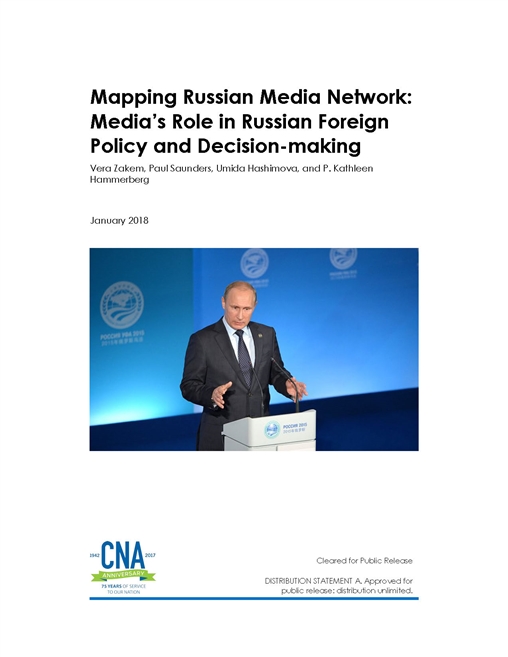Throughout the Soviet era and into the present-day, media has played an important role in Russian foreign policy. In recent years, particularly since the Ukraine conflict, Russia’s use of media as a key lever of broader influence campaigns has gained notoriety domestically and internationally. Today, Russian President Vladimir Putin and his key advisors, often referred to as his “inner circle,” use media to disseminate key messages about Russia’s foreign policy agenda, discredit Western institutions and foundational elements of Western democracy, reduce social cohesion, and promote Russia’s role in the international system. To better understand these dynamics, CNA has initiated a study that maps Russia’s media network and the decision-making process of President Putin and his advisors.
CNA gathered data using Russian and English language sources reviewed primary messaging from the Kremlin, and evaluated the role that media plays in Russian foreign policy. We supplemented our research with semi-structured conversations with subject matter experts on Russian decision making in the media sphere. After validating our insights with subject matter experts, we developed overarching key takeaways to help policy makers better understand the role that media plays in Russian foreign policy and decision-making.
Key Insights and Takeaways
Television is the most popular source of information for Russian citizens, followed by the internet, radio, and print media. The Russian government directly controls and operates state media and exercises considerable influence over private media through both formal and informal means while seeking greater control over media with larger audiences. Russia’s rich business elite, commonly referred to as “oligarchs,” owns most of Russia’s media. Our assessment highlights that President Putin has links to most media-owning oligarchs.
President Vladimir Putin and his inner circle view domestic and international media as key instruments in promoting Russian state interests. Russia’s media has three primary functions in contributing to Russian foreign policy: mobilizing and sustaining domestic political support for its foreign and security policies; presenting official perspectives and policies to foreign audiences; and influencing foreign audiences through disinformation and propaganda.
The Presidential Administration plays a central role in aligning Russia’s media strategy and messaging with the Kremlin’s foreign policy objectives on a day-to-day basis. Putin selectively exercises personal leadership, known as “manual control” or ручное управление, when Russia’s political system, his personal legitimacy, or Russia’s national security are at stake. Putin also often personally delivers key messages, something that can attract considerable domestic attention as well as large international audiences extending well beyond those accessible solely through Russia’s state-controlled external media. Surrounding President Putin is his inner circle of key advisers whom we classify as messengers, strategists, bureaucrats, and owners. A detailed map of President Putin and his media “inner circle” can be found on page 32.
In addition to mapping out Russia’s internal media network and decision-making processes in the media, we developed a baseline assessment of Russia’s external influence. In addition to media, other key levers of influence are culture and society, business, and politics. In analyzing Russia’s broader external influence, we explored Russian media decision-making and messaging in four recent historical cases involving crisis, armed conflict, grey zone, and steady-state. We reached the following conclusions:
Vladimir Putin is likely to exercise “manual control” of Russia’s messaging in high-stakes crisis situations; conversely, if Putin is unavailable, this may complicate Russia’s decision-making, including on messaging
In armed conflict or grey zone operations, Putin is likely to exercise “manual control” over messaging only at key decision points, when he broadly defines tone and content for subordinates
Most of the time, Putin’s relevant top aides manage Russia’s day-to-day media/messaging activities, even during armed conflict
Putin’s involvement and visibility appears correlated to how high the stakes are for Russia in any given situation, with Putin playing more of a leading role in the grey zone conflict in Ukraine, for example, than in political interference in Montenegro
Moscow’s refusals to acknowledge some of its covert and overt conduct may have aims other than deception, such as preserving freedom of action, winning leverage through ambiguity, or allowing its adversaries to save face.
Download reportDISTRIBUTION STATEMENT A. Approved for public release: distribution unlimited.
Details
- Pages: 92
- Document Number: DRM-2017-U-015367-3Rev
- Publication Date: 1/8/2018
